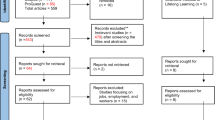Abstract
This article focuses on the role of universities in the promotion of intergenerational learning and the facilitation of reciprocal sharing of expertise among learners of all ages. The principles of the Age Friendly University are used as a particular lens for interpreting two university programs, one in the United States and one in Ireland. Though different in operational implementation, core commonalities emerged within the nature of benefits to younger learners, older learners, the university, and the community. A review of these benefits illustrates how universities can provide opportunities for older and younger learners to co-create experiences and mutually enrich each other’s lives.

Similar content being viewed by others
References
Blieszner, R., & Artale, L. M. (2001). Benefits of intergenerational service-learning to human services majors. Educational Gerontology, 27, 71–87.
Blouin, D. D., & Perry, E. M. (2009). Whom does service learning really serve? Community-based organizations’ perspectives on service learning. Teaching Sociology, 37, 120–135.
Bringle, R. G., & Hatcher, J. A. (1996). Implementing service learning in higher education. The Journal of Higher Education, 67, 221–239.
Butcher, J., Bezzina, M., & Moran, W. (2011). Transformational partnerships: A new agenda for higher education. Innovative Higher Education, 36, 29–40.
Cambridge, J., & Simandiraki, A. (2006). Learning for intergenerational practice: A typology for description and analysis. International Justice Review, 6, 43–44.
Chesterton, G. K. (1924, July 5). Selected quotes from G. K. Chesterton. Illustrated London News (no pagination). Retrieved from http://www.cse.dmu.ac.uk/~mward/gkc/books/quotes.html
Clifford, D., & Petrescu, C. (2012). The keys to university–community engagement sustainability. Nonprofit Management and Leadership, 23, 77–91.
Corrigan, T. (2011). Intergenerational learning: An evaluation of an emerging pedagogy. Unpublished doctoral thesis. Dublin City University, Dublin, Ireland.
Davidson, W. S., Peterson, J., Hankins, S., & Winslow, M. (2010). Engaged research in a university setting: Results and reflections on three decades of a partnership to improve juvenile justice. Journal of Higher Education Outreach and Engagement, 14, 49–67.
Dantzer, F., Keogh, H., Sloan, F., & Zekely, R. (2012). Learning for active ageing & intergenerational learning (Report). (n.p.): European Network for Intergenerational Learning.
Denner, J., Cooper, C. R., Lopez, E. M., & Dunbar, N. (1999). Beyond “giving science away”: How university community partnerships inform youth programs, research, and policy. Social Policy Report, 8(1), 1–18.
Dey, I. (2005). Qualitative data analysis: A user friendly guide for social scientists (e-book). New York, NY: Routledge.
Dublin City University (2015). Age Friendly Principles. Retrieved from http://www.dcu.ie/agefriendly/principles.shtml
Dorfman, L. T., Murty, S., Ingram, J. G., & Evans, R. J. (2003). Incorporating intergenerational service-learning into an introductory gerontology course. Journal of Gerontological Social Work, 39, 219–240.
Eyler, J., Giles, D. E., & Braxton, J. (1997). The impact of service-learning on college students. Michigan Journal of Community Service Learning, 4, 5–15.
Holland, B. A., & Gelmon, S. B. (2003). The state of the “engaged campus”: What have we learned about building and sustaining university–community partnerships? In S. Jones (Ed.), Introduction to service-learning toolkit: Readings and resources for faculty (2nd ed., pp. 195–198). Providence, RI: Campus Compact.
Honnet, E. P., & Poulsen, D. (1989). Principles of good practice for combining service and learning. Racine, WI: The Johnson Foundation.
Kaplan, M., Kusano, A., Tsuji, I., & Hisamichi, S. (1998). Intergenerational programs: Support for children, youth and elders in Japan. Albany, NY: State University New York Press.
Karasik, R. J. (2005). Breaking the time barrier: Helping students “find the time” to do intergenerational service-learning. Gerontology & Geriatrics Education, 25, 49–63.
Lave, E., & Wenger, E. (1991). Situated learning: Legitimate peripheral participation. Cambridge, United Kingdom: Cambridge University Press.
Lear, D. W., & Sánchez, A. (2013). Sustained engagement with a single community partner. Hispania, 96, 238–251.
Markus, G. B., Howard, J. P. F., & King, D. C. (1993). Notes: Integrating community service and classroom instruction enhances learning: Results from an experiment. Educational Evaluation and Policy Analysis, 15, 410–419.
McKnight, J., & Block, P. (2010). The abundant community: Awakening the power of families and neighborhoods. San Francisco, CA: Berrett-Koehler.
Parahoo, K. (2006). Nursing research: Principles, process and issues. Basingstoke, United Kingdom: Palgrave Macmillan.
UNESCO (2000). Intergenerational programmes: Public policy and research implications. An international perspective. Hamburg, Germany: The UNESCO Institute for Education and The Beth Johnson Foundation.
VERBI Software (1989-2014). MAXQDA software. Berlin, Germany: VERBI Software.
Weerts, D. J. (2005). Facilitating knowledge flow in community-university partnerships. Journal of Higher Education Outreach and Engagement, 10, 23–38.
Weigert, K.M. (1998). Academic service learning: Its meaning and relevance. In R. A. Rhoads & J. P. F. Howard (Eds.), Academic service learning. A pedagogy of action and reflection. New Directions for Teaching and Learning, vol. 73 (pp. 3–10). San Francisco, CA: Jossey-Bass.
Wenger, E. (1998). Communities of practice: Learning, meaning and identity. New York, NY: Cambridge University Press.
Wilson, D. (2004). Key features of successful university-community partnerships. In K. Ferraiolo (Ed.), New directions in civic engagement: University Avenue meets Main Street (pp. 17–23). Charlottesville, VA: Pew Partnership for Civic Change.
Author information
Authors and Affiliations
Corresponding author
Rights and permissions
About this article
Cite this article
Pstross, M., Corrigan, T., Knopf, R.C. et al. The Benefits of Intergenerational Learning in Higher Education: Lessons Learned from Two Age Friendly University Programs. Innov High Educ 42, 157–171 (2017). https://doi.org/10.1007/s10755-016-9371-x
Published:
Issue Date:
DOI: https://doi.org/10.1007/s10755-016-9371-x




